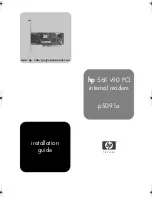
3 AT Commands
CommPlete Communications Server
19
@
Quiet Answer
Use the
@
command to access a system that does not provide a dial tone. The
@
command causes the
modem to wait before processing the next character in the dialing string. The wait is for one or more rings
back followed by five seconds of silence.
For example,
ATDT5551212@6313550
causes the modem to dial the first number (555-1212), then wait
for the time specified in register
S7
for at least one ringback and five seconds of silence. If the modem
detects a busy signal, it hangs up and generates a
BUSY
result code. If it does not detect five seconds of
silence, it hangs up and generates a
NO ANSWER
result code. If it does detect five seconds of silence, it
dials the second number (631-3550).
$
Call Card Tone Detect
Use the
$
command to dial services that require you to enter your call card number after a tone. A
$
character in the dialing string causes the modem to pause and wait for an AT&T call card “bong” or a 1600
Hz tone (prevalent in the U.K.). When the modem detects the tone, it processes the rest of the dialing
string. If it does not detect a tone within the time set by register
S7
(a 45-second default), the modem
aborts with a
NO CARRIER
message. Pressing any key also aborts the
$
command.
In the following example, the
$
command is placed between an access/phone number and the caller’s
credit card number:
ATDT1028806127853500$123456789
Phone Number Memory Commands
The modem can store up to two telephone numbers in nonvolatile memory. You can store the numbers
with the
DsNd
command, dial them with the
Nd
command, link them so that one will be automatically
dialed after the other with the
NdNe
command, or list them with the
L
command.
DsNd Store a Phone Number
s
= phone number
d
= 0 or 1
Default: none
You can store a telephone number command string of up to 60 characters in the modem’s phone number
memory. You can store two of these 60-character strings using the
DsNd
command. The memory
locations are labeled
N0
and
N1
.
Store a command line by typing it as you would any other command, appending the appropriate Nd
memory location.
For example, the tone-dialed number 1-612-555-1212 is stored at memory location N0 by typing
ATDT16125551212N0
and pressing E
NTER
. The number is not dialed with this store command.
After storing a number, check to see that it has been stored correctly by typing
ATL
and pressing Enter.
When you store a phone number, you store the entire command string, so you can effectively create a
macro for each number. For example, if you know a particular number needs to have extended result
codes, detect busy or dial tone, error correction, XON/XOFF flow control, pacing, and data compression enabled, the
command to store the entire command string at location N0 is
ATX4&E1&E5&E13&E15DT16125551212N0
.
Nd
Dial a Stored Number
d
= 0 or 1
Default: none
Содержание CommPlete MT3334HD8
Страница 1: ...MT3334HD8 Modem User Guide ...
Страница 7: ...CommPlete Communications Server 1 1 Introduction ...
Страница 13: ...CommPlete Communications Server 7 2 Installation ...
Страница 16: ......
Страница 17: ...CommPlete Communications Server 11 3 AT Commands ...
Страница 50: ...MT3334HD8 User Guide 44 CommPlete Communications Server ...
Страница 51: ...CommPlete Communications Server 45 4 S Registers ...
Страница 59: ...CommPlete Communications Server 53 5 Testing the MT3334HD8 ...
Страница 64: ......
Страница 65: ...CommPlete Communications Server 59 6 Warranty Service and Technical Support ...
Страница 72: ...MT3334HD8 User Guide 66 CommPlete Communications Server ...
Страница 73: ...CommPlete Communications Server 67 Appendixes ...
Страница 93: ...CommPlete Communications Server 87 Index ...
Страница 99: ......
Страница 100: ...P N 82063701 ...















































